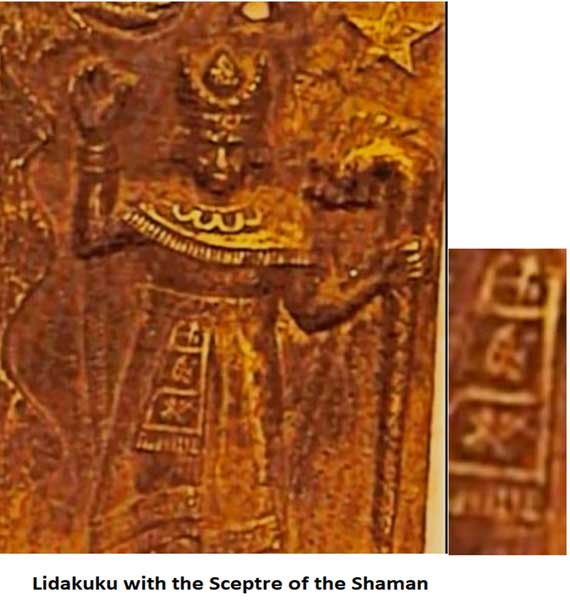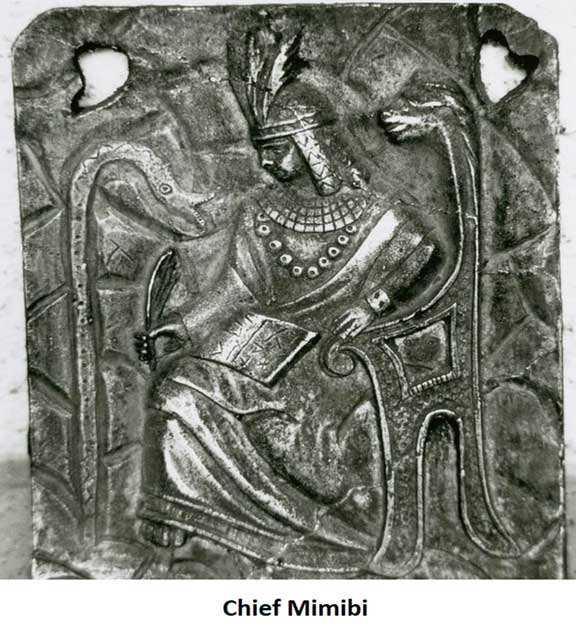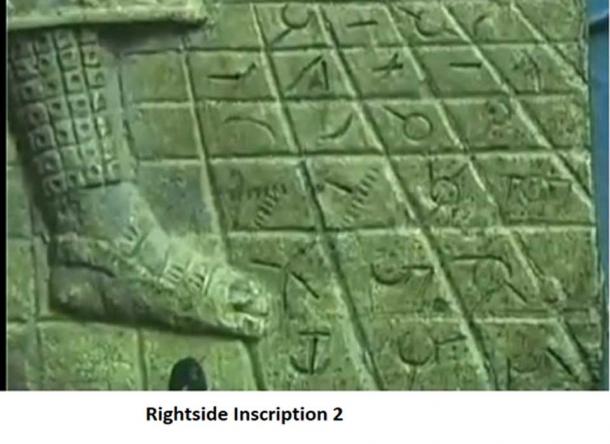It is becoming more and more obvious that the Sumerians had founded Kuga-Ki, a colony in South America. In Sumerian inscriptions, Kuga-Ki was referred to as the “Tin Country of the West” or the “Sunset Land.”


South American Sumerians
In South America, there are several Sumerian artifacts with inscriptions. Linear Sumerian writing can be seen on the Pokotia monument and the Fuente Magna bowl. The Fuente Magna Bowl, the Pokotia monument, and the identification of Sumerian place names in the Altiplano all contain Sumerian writing, indicating that Ecuador and Bolivia were connected via Kuga-Ki.
Some of the gold tablets in the Crespi Collection may also feature linear Sumerian writing, according to some researchers. Thousands of items that Father Carlos Crespi Croci claimed were discovered by indigenous Indians in Ecuadorian caverns were amassed by him. Father Crespi passed away in 1982 but was born in Milan, Italy, in 1891.
The Crespi Collection is said to include a sizable number of engraved tablets. Several of the ancient tablets in the Crespi Collection were first made known to us by Erich von Daniken in Chariots of the Gods.
I’ve been eager to read the Crespi Tablets for a long time. Yet since we just have pictures of the Tablets, I refrained from trying to read them. It can be challenging to read the writing since the inscriptions are frequently not fully depicted in the images of the Tablets or the lighting is inadequate.
Notwithstanding this, I shall make an effort to read some of the Crespi Tablets since they could shed light on the religion and culture of the Sumerians at Kuga-Ki. I deciphered the Crespi Metal Tablets using the Ball and Halloran Sumerian word lists.
Viewing the Crespi Tablets That Are Available
I go into detail about the Sumerian symbols discovered on the textiles of the Inca Sagas in my book Ancient Scripts in South America. Several Inca emperors by the names of Saga or Capac can be found in the Guaman Poma, and they all have Proto-Sumerian symbols like those on clothing worn by the aristocracy of Ecuador from the Crespi Collection.

Crespi Gold Plate showing a robed shaman (Left). Manco Capac Book Illustration (Right). (Author Provided)
The names of the Crespi elites are either found on the textile hanging from the waist of the Shaman or the flaps hanging down from the headband of the Chief.
The Crespi Tablets include two Shaman. The left hand of the first Shaman is holding a stick. The right hand is raised in a welcoming gesture. The cloth hanging from this Shaman’s waist bears his name.

Crespi Gold tablet with shaman, detail of waist textile. (Author Provided)
The textile’s initial three panels include Sumerian symbols. The signs’ transliterations are as follows:
First, Lu pa Mash. Lidakuku No. 2. Mash mi ta, third.
“1) The guy [holding] the Shaman’s Sceptre,” reads the translation. Lidakuku No. 2. Lidakuku, the Shaman, is obligated to the Oracle. The Shaman carried a stick as a sign of power, according to this tablet.
Are the Tablets Home to a Sumerian Chief?
The following Crespi Tablet features a guy seated on a throne holding a stylus in one hand and a paper with writing on it in the other. A headband with flaps dangling from it is worn by the guy. Feathers are seen in this elite’s hair.

Crespi Gold Plate of Chief. (Author Provided)
The flap of the headband has four panels with inscriptions on it. The Chief’s name is written on these panels. We read: 1) Mi mi, 2) Bi, 3) Ga, and 4) Lu from top to bottom. Mimibi the Esteemed Chief is referred to by the signs that read “(1-2)Mimibi, 3[the]Chief 4” on the headband flap.

Detail of Crespi Gold Plate of Chief. (Author Provided)
In Mimibi’s lap, there is a written document. There are three sign columns. As follows:
an I mi mash, I I lu li mi I, and mash are the first three.
We looked at the text below. “The glittering Oracle sees [the man’s ascent], as does the great, powerful oracle [of the Shaman].” Three) This Divine Decree.

Detail of tablet in the hands of the elite. (Author Provided)
Transcription: 1) The strong powerful (man) is the oracle of the Shaman. 2) Witness the powerful man’s rise. The glistening oracle [is its] withness. 3) [This is a] Divine Decree.
A Third Shaman in the Collection
A third Shaman exists. This Shaman has a piece of fabric around his waist. Also, he is positioned on a floor that has panels with writing on it. As we read the markings on the fabric from top to bottom, we see:
Mash is followed by Ta I lu se, ta se, and me i.
The translation is “The Shaman Tailuse links the patron to the oracle rise [it up],” which may also be rendered as “The Shaman, Tailuse, attaches the patron to the oracle.”

Crespi metal tablet with shaman. (Author provided)
A series of inscriptions were located at Shaman Tailuse’s feet. The inscriptions are located on Tailuse’s right and left flanks.

Detail of inscriptions on the Tailuse tablet. (You tube Screenshot, Author provided)
Viewing the inscriptions on the right side of the Tailuse Tablet, starting with the second column of signs and going clockwise, we see the following in transliteration:
2. Ta u ta. i a li ta li
3. i Mash ta I I ta i a a mi i u i
4. Ta mi li u i li su li i ta
5. a i a se jo Mash a a i po

Detail of inscriptions on the Tailuse tablet. (You tube Screenshot, Author provided)
The translation of the rightside inscription of Tailuse says:
2) Let outstanding Character to shine brightly and reveal the truth. 3) See the Shaman Tailuse depart while casting a spell from the Strong Father of the Oracle. See the ascent of the mighty (guy). 4) Give the great man’s glittering oracle your confidence and make libations. See [its] brilliance. Launch the spell. Look at [its] open. 5) The Father [Tailuse] will boost benefits [for everyone] and observe strength. To witness purity, the Shaman [Tailuse] is a powerful Father [of the] Oracle.
Two panels with signs are seen beneath Tailuse’s right foot. They stated:
1) Se jo ta Mash. 2) Lu ki.
The translation of these signs reads: “1) The patron [Tailuse] to benefit [from] and stand by the Oracle. 2) This man is Noble”.

Detail of inscriptions on the Tailuse tablet. (You tube Screenshot, Author provided)
The transliteration of the inscriptions on the left side of the Tailuse Tablet say:
1. Ta I ki ta li i i u i
2. I ta Mash du I ki
3. Mi ki mi i
The translation of the left side of the Tailuse Tablet reveals, “1) Bind the witness [Tailuse] to the Cult; the progenitor of many people [Tailuse] to rise [up] a shining Spell. a magic ritual that feeds exaltation. (2) Develop the Shaman’s Goodness character. See its ascent. 3) The divine command to expound the divine message in a remarkable place.
Text and Representations of Women
Two women are depicted on another intriguing Crespi tablet, with inscriptions on either side of the figures. I haven’t attempted to read the words in the dark markings on the tablet’s left side.

Crespi Two women tablet (Youtube Screenshot, Author provided)
There are four lines of writing on the right side of the Two Ladies Tablet. The following is read top to bottom and right to left:
1. Imi Yu me pa i pa i lu mi pa su.
2. Su me me-I ge mi Mash ka.
3. Ga ta i ta i ta lu ta.
4. Pa I te tata i su ta i
The translation of the Two Women Tablet notes that:
1. “The brilliant, strong oracle act [sends] respect. Bring forth the divine ability to give knowledge to mankind to the progenitor of countless people.
2. To elevate the Shaman, spread the divine illuminating oracle [all across].
3. To raise to touch many people, the Shaman is trusted with exalted character [in the] house.
4. “Proclaim witness to the fear of God, that everyone may have open wisdom and open exaltation.”
The Two Ladies Tablet was intended to symbolize a Temple where people would gather to hear the oracle, according to its inscription. It suggests that women served as the shrine’s matrons and carried messengers from the Gods.
In conclusion, it is evident from the Crespi metal tablets that the Kuga-Ki people valued oracles as a means of speaking and consulting with their Gods. They were recognized as the Father of the (community of) believers and oversaw the performance of religious rites in the Kuga-Ki temples and shrines, according to the Crespi Tablets of the Shaman.
Image at top: Shaman, S
haman and Chief from Father Crespi tablets photos. Images provided by the author.

